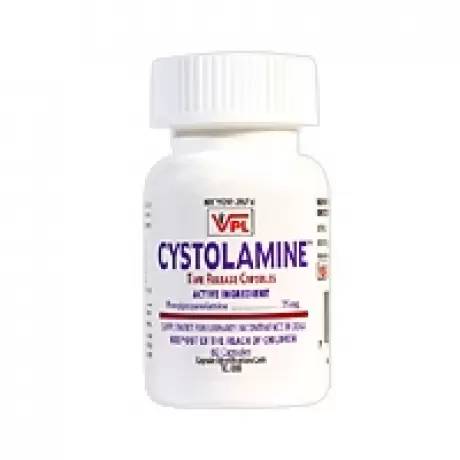
Cystolamine (phenylpropanolamine) Rx
- Phenylpropanolamine to aid in the management of Canine Urinary Incontinence.
**********
Cystolamine is classified as a controlled substance in Oregon and Arkansas. We are unable to ship this product to those states.
**********
CYSTOLAMINE® may help reduce the conditions often associated with high levels of Phenylpropanolamine (PPA) such as:
-
- Decreased appetite
- Changes in heart rate
- Increased blood pressure
- Hyperexcitability
- Contains Phenylpropanolamine (PPA) as the active ingredient in a novel TIME RELEASE CAPSULE
- Increased owner compliance with the once a day time release capsule
- Conveniently packaged in a 60-count bottle for easy dispensing. Also available in an economical 500-count bottle
- Ensures sustained PPA levels in the blood stream
- EACH CAPSULE CONTAINS: Phenylpropanolamine 75 mg.
Client Information Sheet
for
Phenylpropanolamine (Rx)
General Description: Phenylpropanolamine is used in dogs for long-term management of urinary incontinence conditions. This drug improves the tone of the sphincter muscles, particularly the urethra and the bladder neck. Cystolamine capsules are available by prescription from your veterinarian.
What is this drug?
-
An adrenergic agent
-
Given by mouth
Reasons for prescribing:
-
For long-term management of urinary incontinence (urine leakage) in dogs by tightening the bladder sphincter muscle
-
May be used in combination with diethylstilbesterol (an estrogen)
What dogs/cats should not take this medication?
-
Dogs with glaucoma, prostate disease, overactive thyroid, diabetes, heart disease or high blood pressure
-
Pets taking MAO inhibitors (Mitaban® Dip, Preventic® Flea Collars, Anipryl®). Phenylpropanolamine should not be used within 2 weeks of their use.
-
Pregnant and nursing dogs
-
If your pet has had an allergic reaction to phenylpropanolamine or like products before
Directions:
Read and follow the label carefully.
Give the exact amount prescribed and only as often as directed. It is usually given two or three times a day and can be used long-term.
One dose should be given at bedtime to ensure that the drug lasts all night and the pet does not have accidents throughout the night.
Phenylpropanolamine can be extremely bitter and make your pet salivate or refuse treatment. You may want to hide this medication in some food. Do not crush Cystolamine capsules.
Ensure that your pet consumes the entire dose.
Do not give your dog aged cheese or use tick collars while taking phenylpropanolamine.
It may take several days of treatment before urinary incontinence improves.
This medication usually needs to be given long-term, but some pets may only need treatment for several months or seasonally.
Ideally, give the medication at the same time daily.
Call ahead for refills.
What if a dose is missed?
If a dose is missed, give it as soon as you can or urinary incontinence will reappear. If it is time already for the next dose, skip the missed dose and go back to the normal schedule. Do not give two doses at the same time.
What to tell/ask veterinarian before giving medication?
Talk to your veterinarian about:
-
When will your pet need to be rechecked
-
What tests may need to be performed prior to and during treatment with this drug
-
What are the risks and benefits of using this drug
Tell your veterinarian about:
-
If your pet has experienced side-effects on other drugs/products
-
If your pet has experienced digestive upset now or ever
-
If your pet has experienced liver or kidney disease now or ever
-
If your pet has experienced any other medical problems or allergies now or ever
-
All medicines and supplements that you are giving your pet or plan to give your pet, including those you can get without a prescription. Your veterinarian may want to check that all of your pet’s medicines can be given together.
-
If your pet is pregnant or nursing or if you plan to breed your pet
Storage and Warnings:
Store in a tight, light resistant, childproof container in a cool, dry place at room temperature away from heat and direct sunlight. Potency is lost after exposure to light.
Keep this and all medication out of reach of children and pets.
Call your physician immediately if you accidentally take this product.
Potential side effects:
-
Phenylpropanolamine was taken off the human market in 1999 because it caused extreme high blood pressure and strokes in some humans. There have been no reports of these effects in animals when used at normal doses.
-
Since it is a stimulant, your pet may experience restlessness, irritability, urine retention, high blood pressure, rapid heart rate and loss of appetite
-
If your pet shows any of these symptoms or you notice anything else unusual, contact your veterinarian
Can this drug be given with other drugs?
-
Yes, but possible interactions may occur with beta-blockers, chlorpromazine, digoxin, ephedrine, epinephrine, halogenated anesthetic agents, nonsteroidal antiinflammatories, reserpine and tricyclic antidepressants
-
Do not use phenylpropanolamine within 2 weeks of using MAO inhibitors (Mitaban® Dip, Preventic® Flea Collars, Anipryl®, isoniazid)
-
If your pet experiences any unusual reactions when taking multiple medications, contact your veterinarian.
Overdosing?
Contact your veterinarian immediately if pet eats more than the prescribed amount.
What else should I know?
Notify your veterinarian if your animal’s condition does not improve or worsens despite this treatment.
As with all prescribed medicines, phenylpropanolamine should only be given to the pet for which it was prescribed. It should be given only for the condition for which it was prescribed.
This is just a summary of information about phenylpropanolamine. If you have any questions or concerns about phenylpropanolamine or the condition it was prescribed for, contact your veterinarian.
©North American Compendiums Inc. 2009. All rights reserved
PPA is also available in 25, 50, and 75 mg chewable tablets. Please see Proin for more information. Ask your veterinarian which PPA is appropriate for your dog.

